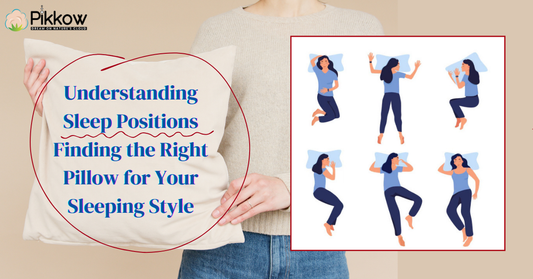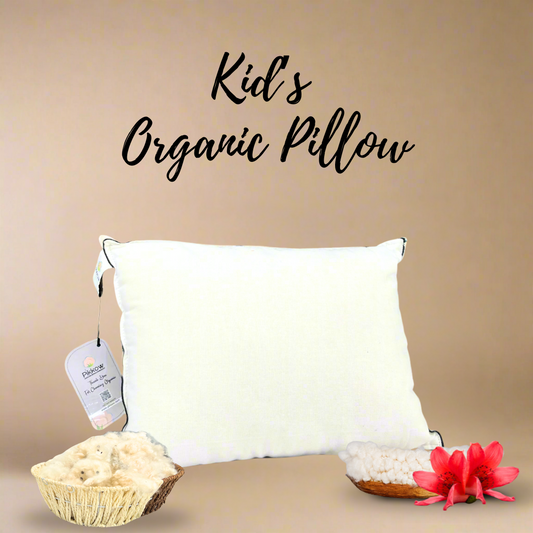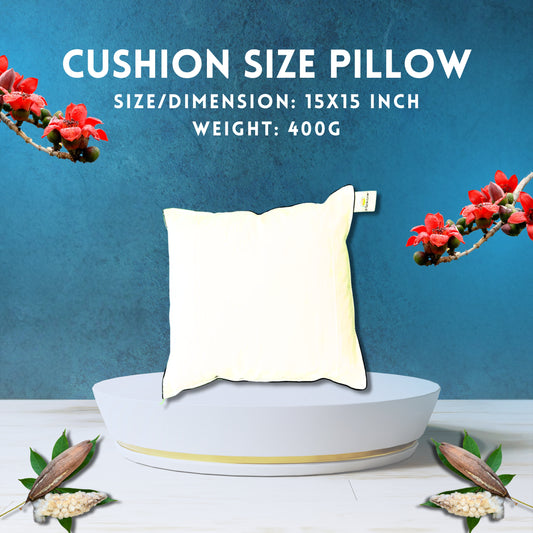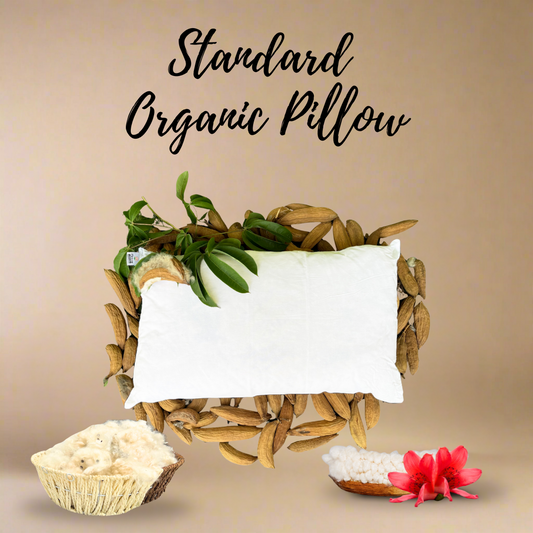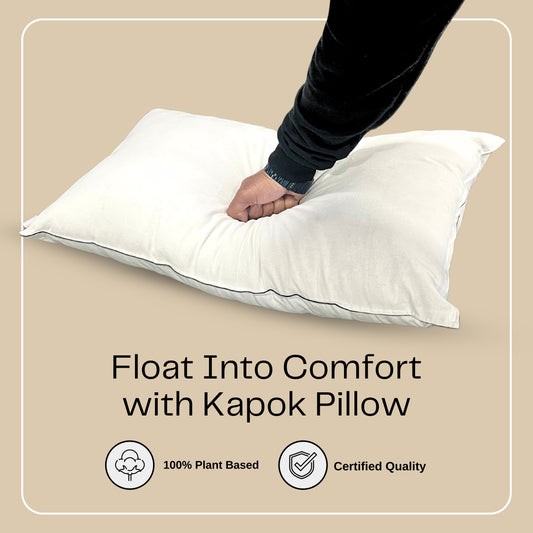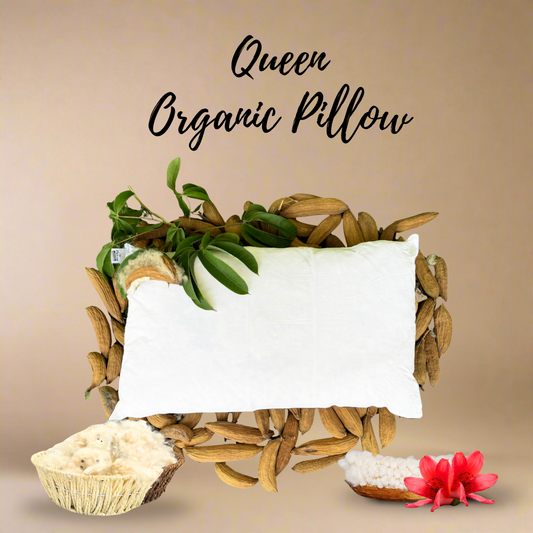If you often wake up with a pounding head, stiffness in your neck, or feel restless even after hours in bed, it’s time to rethink your bedding. The kapok pillow for head pain may be your missing solution. Unlike ordinary pillows stuffed with synthetic foam or polyester, a natural pillow made of kapok seeds offers more than just surface comfort. It provides neck support, gentle massage-like fibre movement, and natural breathability. In India’s humid climate and stressful lifestyle, good sleep isn’t just luxury—it’s a necessity. Let’s understand why switching to organic kapok pillows can change how you sleep forever.
The term “kapok pillow for head pain” captures not just a product but a purpose: relief and better sleep.
Kapok fibre comes from the seed pods of the Ceiba pentandra (kapok) tree, known for its silky, lightweight fibre. Its hollow structure allows excellent breathability and resilience, making it perfect for head and neck support.
A kapok pillow helps relieve head pain by gently adapting to your head’s shape and offering a subtle massage-like comfort as you move during sleep. Because the fibres are naturally soft yet supportive, they cradle your skull without creating pressure points. The material’s breathability keeps your head cool and reduces sweating—another common trigger for tension headaches. Moreover, kapok is chemical-free and hypoallergenic, meaning fewer allergens, toxins, and irritants that can disturb sleep or cause sinus discomfort.
Kapok Pillow vs Synthetic Pillow for Head Pain Relief
|
Feature |
Kapok Pillow |
Synthetic Pillow |
|
Support |
Gently cradles head & neck |
May flatten, poor contour |
|
Breathability |
Excellent airflow |
Often traps heat |
|
Chemicals |
Natural, toxin-free |
May release VOCs |
|
Allergens |
Naturally resistant |
Attracts dust mites |
|
Movement |
Light, massage-like |
Rigid or static |
|
Headache Relief |
Proven tension relief |
Less consistent |
Clearly, the kapok pillow for head pain offers a more holistic approach to comfort, health, and relaxation compared to synthetic options.
Beyond pain relief, a natural pillow for sleep offers several additional benefits. It improves sleep quality by maintaining ideal spinal alignment, reducing neck strain, and preventing frequent awakenings. Kapok’s adjustability allows users to customize the loft and firmness to suit their sleeping position—back sleepers prefer medium loft, while side sleepers may choose a slightly higher one.
Many synthetic pillows either flatten or elevate the head excessively, disturbing natural alignment. A kapok pillow keeps your head level with your spine, reducing tension that often leads to morning stiffness or headaches.
Moreover, its hypoallergenic property minimizes exposure to dust, mould, or harmful chemicals. If you suffer from nasal congestion, allergies, or skin irritation, switching to a natural pillow for sleep like kapok can significantly reduce these issues.
Stress Relief and the Head Massage Effect
Here lies the unique USP of Pikkow’s pillows — the kapok seeds’ natural ability to assist in head massage and relaxation. When you rest your head on the pillow, the fibres gently shift, creating a light, soothing pressure across your scalp. This mimics the effect of a mild head massage, which can stimulate blood circulation and release tension.
In today’s Indian lifestyle — long working hours, digital screens, and commuting — this natural relaxation can make a huge difference. The pillow helps calm your mind and body, making it easier to fall asleep peacefully.
Integrating Kapok Pillows into Your Sleep Routine
-
Choose the right size and firmness.
If you sleep on your back, opt for a medium loft; if you sleep on your side, choose a slightly higher one. Pikkow offers all sizes — Standard, Queen, King, and even Kids Pillows. -
Enhance the head massage effect.
Before sleeping, lightly press or fluff the pillow to settle the fibres. This creates better contour and allows the kapok to offer its natural soothing effect throughout the night. -
Sleep environment matters.
Keep your room cool, dim, and ventilated. Kapok’s airflow property works best in open air. Try using a breathable cotton pillow cover instead of synthetic ones to maintain airflow. -
Regular care and maintenance.
Air your pillow once a month under indirect sunlight. Wash the covers frequently and fluff the pillow weekly to maintain volume and softness. With proper care, a kapok pillow can last 3–5 years — longer than most synthetic options.
Real Experiences and Science Behind It
“I switched to a kapok pillow and noticed my morning headaches reduced drastically. The pillow feels naturally cool and supportive.” — Verified user review from Pikkow Blog
Research from ResearchGate confirms that pillows with proper neck support can significantly reduce waking headaches and improve sleep efficiency. When you sleep on a pillow that maintains natural alignment, blood flow improves, muscle tension decreases, and your body gets the restorative rest it deserves.
Common Questions and Myths
Does a pillow alone cure headaches or migraines?
Not completely — but if your headaches are due to poor sleep posture or neck strain, a kapok pillow for head pain can significantly help reduce the frequency and intensity of episodes.
Is a natural pillow for sleep better than memory foam?
Yes, in most cases. Memory foam retains heat and can release chemicals over time, while kapok pillows are breathable, toxin-free, and naturally cool.
Can kapok pillows suit all sleepers?
Yes. They’re adjustable — add or remove filling for perfect comfort, whether you’re a back, side, or combination sleeper.
Do they cost more than normal pillows?
They may be slightly expensive upfront, but last longer and deliver better health benefits, making them worth every rupee.
How do I clean and maintain a kapok pillow?
Use a breathable cotton cover, air the pillow occasionally, and avoid washing the fibre directly. This keeps it fresh and durable.
Quote to Remember
“Sleep is the golden chain that ties health and our bodies together.” — Thomas Dekker
Let your pillow be that golden link between relaxation and wellness.
Conclusion
In today’s fast-paced Indian lifestyle, where work, screens, and stress dominate our days, good sleep is vital for health and happiness. A kapok pillow for head pain isn’t just another sleep accessory—it’s a natural therapy for your head, neck, and mind. From relieving headaches and reducing tension to improving sleep posture and promoting relaxation, it’s a small change that brings big results.
Pikkow’s organic kapok pillow collection combines eco-friendly design with comfort rooted in nature. Visit the Pikkow Homepage or learn more about their vision on the About Us page. You can also follow Pikkow on Instagram for updates and wellness tips.
Choose consciously. Sleep naturally. Wake refreshed.
Also Read:
Inside the Making of a PIKKOW: The Journey from Kapok Tree to Cozy Sleep
The Future of Sleep: Why “Organic” Will Replace “Orthopedic”
The Ultimate Guide to Choosing the Right Organic Pillow for You
How Switching to Pikkow Can Reduce Plastic Waste in Bedding
Kapok Pillows in India: Why They’re the New Choice for Smart Sleepers
7 Reasons to Switch to Kapok Pillows for Healthier, Deeper Sleep
Pikkow vs Regular Pillows: Why Organic Always Wins
Why the World Should Call Organic Pillows “PIKKOW” — The New Standard of Natural Sleep
Why Organic Kapok Pillows Are Perfect for Dry Winter Nights
FAQs
1. How long does a kapok pillow last?
With regular care, it can last 3–5 years without losing shape or softness.
2. Can it help with migraine headaches?
If your migraine stems from tension or poor posture, yes — a kapok pillow provides gentle support that can help prevent them.
3. Does it really feel like a head massage?
Yes, the natural movement of kapok fibres creates light pressure on your scalp, promoting blood flow and relaxation.
4. Are kapok pillows suitable for kids?
Absolutely. Pikkow offers Kids Pillows specially designed for comfort and support.
5. Are kapok pillows eco-friendly?
Yes. Kapok is a renewable, biodegradable fibre that’s harvested naturally without harming trees, making it one of the most sustainable choices for bedding.



